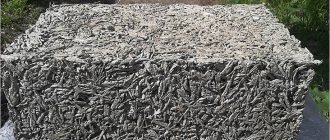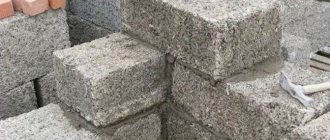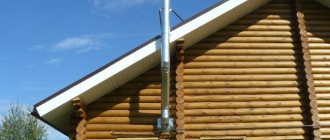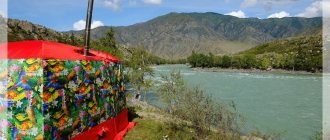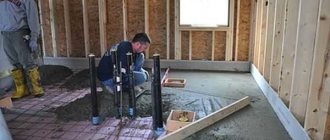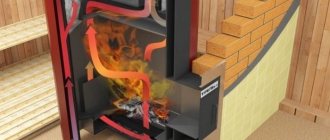A bathhouse built with your own hands is a source of pride. Easy to use, comfortable and aesthetically pleasing to look at. Not every bathhouse needs finishing - it depends on the material it is made of. The log structure itself is beautiful, but its siding will look strange. But if the bathhouse is built from brick, stone or a wooden frame, then finishing it with siding will add that missing charm to the structure, which may be lacking.
- What is siding?
- Is it possible to cover the outside of a bathhouse with siding?
- Bathhouse covered with siding: photo
- What types does it come in?
- Siding for a bathhouse: which is better?
- How much does it cost to cover a bathhouse with siding: prices for material and cost of work
- How to cover a bathhouse with siding with your own hands?
- Where to buy from the manufacturer?
Is it possible to cover the outside of a bathhouse with siding?
Covering bathhouses with siding is gradually gaining momentum. People notice that neat external decoration not only adds attractiveness to the bathhouse, but also protects the material that was the main one in its construction: brick, stone or wooden beams. Sheathing from the inside has become widespread relatively recently. Many people want to preserve the traditional image of a wooden bathhouse not only from the outside, but also from the inside, in the dressing room, even if the bathhouse is built of brick or other non-wood material.
Wooden (log, timber)
The cladding of a wooden bathhouse is the most unpopular, since wood looks more advantageous against the background of buildings made of other materials. But, again, it all depends on certain conditions: from the condition of the wood itself to the correctness of the construction. Perhaps in your case, siding will help hide serious damage and flaws resulting from mechanical stress or after improper construction of a bathhouse. Sheathing is also used as a protective material: wood is less susceptible to rotting and exposure to precipitation.
To prevent condensation from accumulating between the wood and the siding, the cladding must be done using ventilated facade technology with insulation.
Thus, bathhouses made of timber can be finished due to the above problems, but this has not received proper distribution. Still, the appearance of the logs is attractive in itself, and many are accustomed to building baths the old fashioned way, without using any third-party materials.
Frame
Today, when constructing a frame bathhouse, siding is used quite often as a cladding material. The ease of construction compared to a log bath allows you to save a decent amount of money, which can be spent on decorative finishing. Since the walls of frame baths do not retain heat as well as those made of timber, they are additionally insulated. Sheathing is applied on top of the insulation: it increases the strength of the walls and enhances the protective function against moisture and cold. The frame of bathhouses is usually made of coniferous wood, so siding is ordered, as a rule, the one that successfully imitates wood.
Another
Baths built of brick and stone are becoming widespread. They heat up quickly, are less fire hazardous, and finishing with facade slabs will give the building the desired look. The choice of finishing material is distinguished by its variety: there is siding that imitates natural stone, wood or the same brick. The complexity and versatility of texture relief, the use of many shades for every taste - all this is common among cladding materials, and siding is the most popular among them.
Briefly about the main thing
When choosing an external finish for a bathhouse, the issue of the need for external insulation is first decided.
In most cases, it is necessary to leave an air gap between the insulation and the facade materials to ventilate it.
Most often, practical modern materials such as vinyl and metal siding and corrugated sheets are used for cladding.
Wooden panels also remain popular, but they are more expensive and require constant maintenance.
OSB and DSP boards are quite suitable as inexpensive or temporary finishing, and façade panels made of fiber cement, wood-polymer composite or slab insulation with stone finishing will give the bathhouse the most solid look.
Ratings 0
Bathhouse covered with siding: photo
The installation of siding as a cladding material for baths fits perfectly into the image of a summer cottage. A bathhouse stylized to match the desired image brings aesthetic pleasure to the owners, and the protective characteristics of the siding will for a long time relieve the hassle caused by the negative influence of weather conditions: frost, humidity, ultraviolet radiation, etc.
Installation of panels
The photo shows the installation of the starting strip before starting to cover the bathhouse with siding on the outside. The first step is to attach the plinth strip. This will be the starting point on which the level and evenness of the installation will depend, so you should check everything 5 times before starting installation. Mark the installation line for the plinth, it should be 0.2 meters above the level of the ventilation ducts in the foundation. When the bar is secured, check its horizontalness again and if there are no deviations, you can begin the next one.
What types does it come in?
If we focus on such a covering material as siding, then its finishing options are striking in their diversity. Facade siding comes in different types, differing in their structure: concrete, vinyl, metal, wood. Each of them is described in more detail below.
Vinyl
Vinyl siding has become widespread in Russia. It is usually made from two types of PVC, forming two layers: the upper one is protective, and the lower one provides mechanical reliability.
The main advantages of this material are: low cost, light weight and variety of colors.
However:
- upon contact with fire, vinyl siding emits vapors that are dangerous to humans;
- at low temperatures, vinyl becomes very brittle (therefore, it is recommended to use it only for the facade, but not for the base);
- a sharp temperature change threatens the material with deformation;
- If installed incorrectly, condensation will accumulate under the vinyl layer, which contributes to the rapid spread of rot over the entire surface of the bathhouse.
- There are certain restrictions on the depth of texture, which somewhat limits the range of imitated materials.
Metal siding
Every day, metal siding is becoming increasingly popular in the field of cladding materials. It is made of aluminum alloy or galvanized steel and coated with a paint and varnish base. In terms of installation qualities, it is lightweight, but at the same time has sufficient strength. Fire is not a threat to metal siding, nor is cold. Metal calmly tolerates sudden temperature changes, mechanical damage or the harmful effects of ultraviolet radiation.
It would seem that metal siding has some advantages, but its main disadvantage is the paucity of texture variations. Whatever color the front panel is painted, it will be clear that it is a metal product, which, unfortunately, does not coincide with the image that we usually associate with a bathhouse.
Besides:
- if chips form, even a galvanized surface will not save the panel from rust;
- the cost of metal siding is higher than that of wood and vinyl;
- During rain or showers, there will be quite a strong characteristic noise in the room.
Concrete
The real sales leader in the field of cladding materials is fiber cement or, in other words, concrete siding. It has those qualities that customers value so much: high technical characteristics coupled with a variety of textures and colors of products.
So, concrete:
- has high strength, which provides products with the necessary crack resistance and resistance to mechanical damage;
- provides the best protective properties against aggressive external influences: moisture resistance does not allow precipitation to destroy the siding, anti-frost additives make concrete more wear-resistant compared to other materials, the harmful effects of sunlight do not have a negative impact on facade panels, and fungus or termites bypass concrete panels;
- it is fire resistant, which at a critical moment can play the most important role in preserving the integrity of the bathhouse or even human lives, because in the event of a fire, literally seconds count (concrete siding is able to hold back flames longer than other materials);
- allows you to imitate any texture: from simple smooth and wood-like to brick and stone masonry (framed, polished, pebble, rough natural).
Of course, concrete panels cannot be classified as lightweight, therefore, when considering this cladding option, it is necessary to take into account the type of construction - for example, finishing frame baths with concrete is not allowed.
The LOBAS company produces and supplies fiber cement siding. You can view a selection of a wide variety of concrete facing materials on our website.
Under a log/under a tree
Facade siding imitating logs or wood is steadily popular as a cladding material for bathhouses. The main component of its structure is either vinyl or acrylic. It is light, plastic and, in addition to its aesthetic function, performs a protective function, blocking the access of negative climate changes to the surface of the bathhouse.
Among the disadvantages of this type of coating, it should be noted the tendency to form “waviness” due to sudden temperature changes and the likelihood of condensation accumulating between the cladding material and the wall of the bathhouse.
Installation instructions
Installing siding panels is easy. To work, you need to prepare a minimum set of tools that any home craftsman has:
- hammer drill or impact drill;
- metal scissors and stapler;
- level, tape measure and plumb line;
- hammer and pliers.
The sheathing for siding can be made from both ordinary bars and metal profiles.
There is nothing supernatural about installing siding. And given that the bathhouse, as a rule, is not large in size, you do not need to build scaffolding to install the slats under the roof; you can get by with a good stepladder. The material is prepared in advance, and before installation it must be allowed to rest outside the packaging for several days. It is better to choose vinyl panels for a bathhouse; they are less susceptible to moisture.
If enough time has passed since the construction of the bathhouse, that is, the shrinkage process is over, and the log house has already found its permanent place, you can begin work. And first you need to prepare the surface. Recommendations for cladding will be given regarding a log bath, and for each material the preparatory process is carried out in its own way.
First, the surface of the wood is completely cleaned of all kinds of deposits, then the wood is impregnated with fire-resistant preparations and fire retardants to protect against fungus. Afterwards, over the entire surface, with a frequency of 50–60 cm, a sheathing of bars with a section of 50x50 is laid. Here it is necessary to maintain the level. This is easier to do on the walls of a brick bathhouse, because the stone has a uniform surface. Logs can be different in diameter and any differences in level must be filled with small inserts, adjusting each plank to the level.
Lathing made of wooden beams. Less technological option. For vertical alignment, inserts of various sizes are placed under the racks.
If you plan to insulate the bathhouse, then it should be done at this stage, laying the material in the space between the bars. It would be better if, having previously purchased insulation, install vertical sheathing with a step equal to the width of the material. It can be laid without cutting, in a whole roll. Afterwards, the material must be covered with a waterproofing film. They apply it in a horizontal plane, covering the sheathing bars as well. The material is secured to the wood with staples from a construction stapler. All joints are fixed with reinforced tape.
Siding for a bathhouse: which is better?
Of the above types of siding for cladding the external walls of a bathhouse, the most suitable for all technological and aesthetic characteristics are concrete panels. They are easy to install, do not require subsequent maintenance, and meet all technical requirements that are so valuable to the customer:
- high performance qualities, such as wear resistance, strength, frost and fire resistance, moisture resistance;
- unique in their diversity palettes of colors and textures that will emphasize the individuality of a particular bath.
In addition, fiber cement facade slabs are distinguished by a reasonable price for their stated advantages, which is good competition for other types of siding.
General information
Finishing bathhouse panels in a suburban area today is not uncommon, despite the fact that there are many opponents of this type of finishing material. Siding is relatively inexpensive, and its installation does not require the invitation of specialists, since everything can be done with your own hands; you only need to equip yourself with the tools necessary for installation.
Types of siding for finishing
A variety of types, which differ in color, size and material used in production, make it possible to create quite interesting designs. The most common option is vinyl siding. He became the first-born on the Russian construction market, and it was thanks to him that the panels began to be called vinyl, although the expression itself is generalized.
In fact, siding is made from many different materials, there are even wood panels. The variety of structures, colors and types of imitations also make it possible not to focus on one thing. There are embossed, smooth surface, colored and plain panels - the choice is incredible.
Vinyl panels are made from PVC. In this case, during molding, the siding begins to be pressed into two layers - the lower one will be responsible for resistance to mechanical damage, and the upper one, which is treated with protective compounds, will be resistant to climatic factors. These two qualities make it possible to “work” with vinyl panels more efficiently on any surface, be it brick walls or a red bathhouse.
Decor
The decorative type of material is also attractive when covering the bathhouse with siding on the outside. These are special panels that imitate materials such as brick, wood or natural stone. If the material is stitched correctly, the outer finish will perfectly match the structure of the selected imitation material. If you are planning to finish a log bathhouse that is made from untreated logs, then it is better not to use plastic panels.
In this case, it would be more appropriate to buy siding made from pressed shavings, since wood and plastic do not interact well. As you can see, there are no restrictions on installing PVC panels, but you will have to lay additional waterproofing so that condensation does not begin to accumulate on the wood. When using wood panels, this is not required.
How much does it cost to decorate a bathhouse with siding: prices for material and cost of work
Pricing depends on several factors: type of product, region of the manufacturer, complexity of installation. For example, the average cost of 1 m2 of concrete siding in Moscow is 1000 rubles, and in Nizhny Novgorod – 770 rubles.
The LOBAS company has long established itself in the market as a responsible performer. Facade tiles made of fiber cement are made of high-strength concrete in accordance with GOST standards. The price of a product per 1 m2 starts from 600 rubles excluding delivery, which is significantly cheaper than the cost of siding from competing companies.
Vinyl
Of all the options, PVC siding is considered one of the best solutions when it comes to cladding the external walls of a bathhouse. Siding panels are made in two layers; the outer sublayer is saturated with additives that increase the resistance of the plastic to ultraviolet radiation. The inner layer has high density and strength, is not afraid of water, high temperature and deformation.
Vinyl is preferred when planning to cover the outside of a bathhouse with siding for several reasons:
The disadvantages include the flammability of the material and the increased coefficient of thermal expansion.
Also, you should not use vinyl for finishing if the surface is heated unevenly, for example, due to poor thermal insulation, part of the walls in the steam room area heats up to a high temperature, while the rest of the bathhouse remains moderately warm. In such a situation, vinyl panels are easily deformed and lose their original appearance.
Wood
Natural wood panels are practically not used for additional finishing of baths. It turns out to be unprofitable in terms of price and operating conditions. Pure wood siding does not provide any additional advantages over vinyl or metal and is often used as a restoration finish for old frame or log baths.
Aspen siding is often used for the restoration of original sauna buildings, when the sauna owner needs to restore and update the previous appearance of the building. Old log houses and boxes with carved crowns, platbands and shingled roofs are never sheathed with plastic. In this case, finishing with wooden siding will be the only correct solution.
An excellent alternative to wood are panels made from polymer-sawdust or decking boards. In appearance, such siding cannot be distinguished from natural wood by its pattern and texture, the price is affordable, and its resistance to sun and moisture corresponds to the characteristics of vinyl panels.
Cladding with wood-look metal panels
Metal siding panels
The most expensive and durable finishing option. It is widely used for decorative design of frame residential buildings. Siding metal can last at least 25 years without signs of corrosion on the front surface. Unlike vinyl, it perfectly withstands the strongest gusts of wind, which often happens if the sauna box is installed in an open area.
Not every bathhouse can be lined with metal siding on the outside. Metal panels have one significant drawback - the high thermal conductivity of the material. This means that if the walls of the bathhouse have high vapor permeability, and this is how good steam rooms should be, then in winter ice will definitely build up on the inside of the finish. As a result, the decorative finishing of the bathhouse may simply collapse under its own weight.
The vapor permeability of a sandwich made of OSB board and polystyrene foam is practically zero, in addition, there is almost no shrinkage of the structure, so for this type of bathhouse box, finishing the walls with metal will be the ideal solution.
Tsokolny
The lower part of the wall, adjacent to the foundation of the bathhouse, is considered the most vulnerable to moisture. The wooden crowns on the base are rotting, the brick walls of the bathhouse are overgrown with moss. Therefore, to combat negativity, several types of basement siding are used:
Vinyl siding can be used to finish the base of the bathhouse. For example, if you need to cover the lower part of the walls of a timber or log steam room. It is clear that the problem of damaged crowns cannot be solved in this way, but vinyl material is quite suitable as a decorative finish.
How to cover a bathhouse with siding with your own hands?
In order to tile a bathhouse yourself, it is not at all necessary to have a special education. It is enough to approach construction responsibly and competently study all technical issues so that subsequently no problems arise during installation and further operation.
For glue/CPB
To install facade slabs with glue or DSP, materials and tools are used such as:
- building level;
- Master OK;
- Bulgarian;
- tape measure or ruler;
- brush for cleaning the surface, brush;
- primer;
- glue or DSP.
Before starting installation work, the surface of the façade should be cleaned of dirt and dust and coated with a layer of primer for better adhesion. At the same time, it is necessary to give the panels the required dimensions by cutting off the excess parts with a grinder.
The next step is to lay DSP or tile adhesive on the back side of the panel and level the solution with a trowel.
Concrete slabs are laid joint-to-joint, and the seams are covered with polyurethane foam to reduce heat loss. It should be noted that the mounting foam or adhesive must be selected for the climatic region of construction, since sudden temperature changes can affect an incorrectly selected adhesive component, and then the concrete siding may crack or fall off.
Alignment of installed siding panels occurs first manually, and after connecting to the surface, using a building level.
You can also familiarize yourself with the process of installing concrete siding with glue in the following video.
On the sheathing
Before you begin plating the bathhouse, you should carry out preparatory work.
If the bathhouse is built of wood, then you need to wait until it shrinks completely so that after installation the façade siding continues to perform its protective and aesthetic functions for many years.
First of all, you need to correctly calculate the amount of siding that will be needed for cladding the bathhouse. To do this, we calculate the area of the surface to be covered, subtract from it the area of window and door openings and divide by the area of one façade panel. The resulting value is the number of slabs required for installation.
To work, you need to prepare the following materials and tools:
- building level;
- grinder;
- hammer drill and screwdriver;
- hammer and hacksaw;
- tape measure or other measuring device;
- brush or rag;
- additional elements (planks, corner supports, corners, profiles, ebbs, screws or other fasteners);
- stapler (for attaching the protective membrane).
First you need to install the sheathing on which the façade panels will be supported. It should be noted that when installing horizontal siding, the sheathing is installed vertically, and when installing vertical siding, it is installed horizontally. The sheathing pitch is no more than 40 cm.
We recommend using galvanized metal sheathing, since wood sheathing must be protected from rot, fire and insects. Plus, you can’t use it raw, as it will shrink when it dries.
The first step is to trim the fiber cement panels with a grinder to the required configuration. Then you should clean the cut siding from construction dust using a brush or dry cloth.
First, straight hangers are installed, and profiles are attached perpendicularly to them with hardware. We use dowels 100-140 mm long if the surface of the bathhouse is insulated or will be insulated.
The Crab profile connector can also be used to connect profiles.
Simultaneously with the installation of the sheathing, we recommend insulating the walls by laying layers of insulation in the space between the profiles. After installing the insulation, a protective membrane should be secured to its surface using a stapler. This will provide the façade with hydro- and vapor barrier.
The next step when covering the bathhouse is to set a guideline for the subsequent correct installation of the ebb. You can stretch the string to determine the accuracy of laying the façade panels. Using a level, check the parallelism of the tensioned thread.
We install the ebb and flow panels using self-tapping screws or dowels no less than 25 mm long onto embedded parts. Siding installation is done to the right or left towards the center and always from bottom to top. It is necessary to monitor the accuracy of installation, periodically checking with a level the accuracy of fastening the facade slabs.
Corner panels are mounted end-to-end or overlapped.
Walls finished with fiber cement siding acquire the desired aesthetics in the appearance of the entire bathhouse, forcing you to admire its appearance.
The following video shows how to cover a bathhouse with concrete siding using ventilated facade technology.
How to sheathe a pediment?
The pediment is the upper part of the house, bounded by two slopes. Let's look at gable cladding using fiber cement siding as an example. The cladding of the upper part of the house occurs in stages. First, you need to prepare the surface (clean off dirt and dust, cut down protruding parts with a grinder), and also use a laser or improvised means to measure the plane of the pediment in order to subsequently accurately install the vertical hangers.
The procedure for installing siding will be as follows.
- Before installing the panel, we apply it to the next one, align it along the edge, insert it into the lock and mark the edge of the next element with a pencil.
- Next, we place one panel on top of the other, outline the corners, cut off unnecessary material - and both parts of the siding are ready for installation.
- Installation of concrete panels is carried out using embedded parts and hardware. If the surface is concrete or brick, then the siding is secured with dowels - 6x40 mm nails, if wooden - with self-tapping screws.
- Assembly is quick: the selected panel is interlocked with the previous lower part, and the upper part is attached to the wall with dowels.
- The seams of the cladding are not sealed, which ensures complete ventilation of the facade. If the surface of the gable is smooth, then the use of sheathing is not necessary.
After the gable is completely sheathed, it is necessary to mount the overhang with siding panels, having previously calculated that there will be a coincidence joint to joint.
After covering with siding, its surface should be cleaned of construction dust accumulated during installation.
Installation - step by step instructions
Installing siding panels is actually not difficult.
For work, you should prepare a minimum set of tools, and everyone will have these in their home:
- Metal scissors, stapler.
- Impact drill or hammer drill.
- Pliers and hammer.
- Tape measure, level, plumb line.
You can make lathing for siding from metal profiles or from ordinary bars. There is nothing super complicated about installation. Taking into account that the bathhouse is usually not too large in size, installing the slats under the roof does not require the manufacture of scaffolding; a good stepladder is quite suitable. The material should be prepared in advance and before installation if you need to let it rest without packaging for a couple of days. For a bathhouse, vinyl siding would be the ideal choice, since it is less susceptible to moisture than other types.
Enough time will pass from the moment the construction of the bathhouse begins, and if the shrinkage process ends and the log house finds its permanent place, you can begin covering the bathhouse with siding with your own hands. First you should prepare the surface. Recommendations for cladding will be based on a log bathhouse, and for each material the preparatory process is slightly different.
First, the surface of the wood should be completely cleaned of any types of deposits, and then the wood should be treated with fire retardants and antiseptics to protect against fungus. After this, you should fill the sheathing of bars in increments of 0.5-0.6 meters. Here you must definitely maintain the level.
On the walls of a brick bathhouse, this will be much easier to do, since the stone has a uniform surface, but the logs are different in size and diameter, and with any difference, the level should be replenished with the help of small inserts, and each plank should be adjusted to the level. Sheathing made of wooden beams is not the most technologically advanced option, since for vertical alignment you will have to place inserts of various sizes under the racks.
If you plan to carry out work on insulating a bathhouse, then this should be done at the stage of laying the material when you can insert insulation between the bars. It will be better if you buy insulation in advance and install a vertical type of sheathing with a pitch that is equal to the width of the material. It should be laid without cutting, in one piece.
After this, cover the insulation with a waterproofing film, which is laid in a horizontal plane, while also covering the bars. The material should be attached using staples from a construction stapler. Secure the joints with reinforced tape.
Where to buy from the manufacturer?
When finishing a bathhouse with concrete siding, it is necessary to ensure not only the external beauty of the cladding, but also the high performance characteristics of fiber cement panels. The LOBAS company is ready to present to your attention concrete facade slabs of a wide variety of textures and colors. They are made of high-strength reinforced concrete and have all the important characteristics that help maintain the attractive appearance of the bathhouse, as well as protect it for the longest possible service life.
Frost resistance, fire resistance, moisture resistance, high strength, resistance to ultraviolet radiation, wear resistance and long service life - all this characterizes our products, produced under the brand of proven quality for a decade and a half. Moreover, all products regularly undergo quality checks in independent research laboratories, and their quality is confirmed by various certificates of conformity.
Sometimes individual questions require specialist advice. Our employees are ready to help you at any stage of the production process: from making drawings according to your wishes to ordering fiber cement boards of non-standard sizes or rare textures. If you find it difficult to decide on the choice of concrete siding, our managers will always help you choose the best option. Call our toll-free number and we will be happy to answer all your questions!
*Not a public offer. Check current prices on the company's website.
Thus, covering a bathhouse or house with fiber cement siding is the best option among all others. The protective characteristics of concrete will help protect the building from the negative impact of the outside world, and the ease of installation will not cause any trouble. The appearance of the panels will give the bathhouse or home an attractive beauty, and the low cost will pleasantly surprise the buyer.
Front area finishing
The cladding of the front part of the steam room is made from the material used for finishing the facade. The material used in the construction of this segment of the bathhouse is also important:
- The wooden pediment can be covered with any material. First you need to install waterproofing, for which a membrane material is used.
- The concrete gable parts are pre-leveled, the sheathing is attached to them, and the sheathing is mounted. The use of molded relief elements is permitted.
Attaching the sheathing material to the pediment is done in several ways:
- Using aluminum stands. They are attached directly to the gable surface of the bathhouse building.
- If the upper front part of the facade is made of wood, the siding is attached directly to the surface.
- Using slats made from wooden materials. The elements are pre-installed on the gable part of the building.
After covering the gable and roof, drains must be installed and a sewerage system for wastewater must be installed. These measures will provide additional protection to the building.
Is external insulation necessary?
Baths come in different types: wooden, frame, built of brick and concrete blocks. And they are used in different ways: some often and throughout the season, others only in the summer, once a week. Before you can cover the outside of a bathhouse cheaply and beautifully (or expensively and solidly), you need to resolve the issue of the need for its external thermal insulation. Then it will be more difficult to do this - you will have to remove and redo the decorative cladding.
When thermal insulation is not required
It is clear that summer baths, even those used daily, do not need insulation. But not all all-season buildings need it.
- Log or timber bathhouse.
They are dressed in a “fur coat” only for commercial use, when it is important to keep warm constantly and spend less money on heating. To insulate private baths, high-quality caulking of the seams is sufficient to prevent heat leakage through the cracks. Wood has very low thermal conductivity, it “holds” the temperature inside the steam room well and does not allow frosty air from the street to penetrate. And if the frequency of fires does not exceed 2-3 times a week, there is no point in external insulation.
A log house made of timber with windproof seams does not need to be insulated. Source i1.wp.com
- Frame bath.
In such structures, thermal insulation material is already part of the structure.
- Periodic baths.
If you steam no more than once a week, it makes no sense to insulate the bathhouse from the outside, regardless of the material of the walls. During this time, it will freeze through in any case, unless you maintain a positive temperature in it with heating devices. Therefore, you don’t have to worry about this and think only about how best to line the outside of the bathhouse.
When is it better to insulate a bathhouse?
It is necessary to insulate the walls from the outside if:
- the sauna is heated frequently and it is necessary that it does not get too cold between sessions, especially if there is water left in the tank;
- the number of steamers in a family or company is large, the procedure takes a long time and it is necessary to maintain the desired temperature all this time.
In such cases, external thermal insulation significantly reduces fuel consumption, which ultimately saves money and simplifies the work of the stoker. It is especially needed for buildings built from heat-intensive materials - concrete, stone, brick.
High-quality insulation saves energy, time and money for the bathhouse owner. Source yandex.net
Basic Rules
When selecting materials for cladding a house from the street, be sure to remember that in order to maintain normal humidity in the rooms, the vapor permeability of the materials must decrease from inside the room to the outside. That is, the exterior finishing should conduct steam better than the wall material. Then the increased humidity, which is typical for our homes, will be removed through the walls naturally (explanations in the photo).
When deciding what is best to sheathe the outside of the house, do not forget to take into account the vapor permeability of the materials
If this principle is violated, moisture will accumulate at the interface of materials with different vapor permeability. It condenses, creating conditions for rotting and the development of fungi and mold. In winter it freezes, destroying the wall material and/or finishing. Sooner or later such a system will have to be dismantled and rebuilt.
The trouble is that only wood meets this requirement. Most other materials for exterior decoration of a house have low vapor permeability. The problem is solved in two ways:
- A ventilated facade is being installed. A ventilated gap with a width of 60 mm to 150 mm is left between the wall or insulation layer (with high vapor permeability) and the finishing. Ventilation holes are left at the bottom of the cladding at the rate of 75 cm² for every 20 m² of wall, including windows and doors. Air will enter through them. There are exit holes at the top. With this device, moisture will be removed from the wall material or insulation, and the outer cladding will protect from precipitation and perform a decorative function. The principle of finishing a house using a ventilated facade
- The finishing material is attached directly to the wall. But from the inside the wall must be protected by a layer of vapor barrier. In this case, the penetration of vapors into the wall material is prevented and it remains dry. Excess moisture is removed by the ventilation system.
Today the second option is becoming increasingly popular. Very effective thermal insulation materials have appeared that can significantly reduce heating costs. But they have very low vapor permeability (expanded polystyrene and extruded polystyrene foam). When using them, only the second humidity control scheme is possible. When choosing what to cover your house with, consider these points.
Decorative design of the pediment
What is the best way to cover the gable of a bathhouse? The answer to this question depends on what material was used to manufacture it and decorate the facade of the building.
- The wooden pediment is sheathed with any material with preliminary waterproofing of the surface.
- Concrete and brick pediments have no restrictions; the only requirement is leveling the surface and installing sheathing under the cladding.
The pediment cladding is made with the following materials:
- professional sheet;
- siding;
- bitumen shingles;
- block house;
- stucco.
The finishing material is attached to the pediment on a prepared surface, on a wooden sheathing or aluminum posts.
To decide what material to cover the facade of a bathhouse with, it is important to take into account not only your financial and technical capabilities, but also the design features of the structure. At the same time, all the work on installing the cladding can be done independently, the main thing is to follow the basic rules and recommendations.
Lining for external work
How else to cover the outside of the bathhouse? Most often, plastic lining is used to create a budget finishing option. This is perhaps its main advantage. One panel is approximately 60 mm wide. It is produced in a fairly wide range of colors, which allows you to choose almost any color. But for this coating, colors that imitate wood are most often used.
The range of its shortcomings is quite wide:
- Plastic does not allow air to pass through;
- There is no naturalness and environmental friendliness desired for a bath;
- Bends and cracks easily;
- When burned, it releases toxic fumes.
Wooden lining is more environmentally friendly and natural. It allows the surface to breathe. Therefore, if possible, it is better to give preference to it.
Important requirements when working with simulation wood
We recommend watching
That’s it, now it’s up to you how to cover the outside of the bathhouse . There are enough materials and construction products, the main thing is to clearly calculate everything and act carefully.
In addition, before repairing, do not forget to read the instructions and strictly adhere to them during the work process.
Sources:
https://sdelatbanyu.ru/steny/otdelka-snaruzhi.html https://domunit.ru/chem-obshit-banyu-snaruzhi.html
Finally, some tips
How to cover a bathhouse with siding as accurately and correctly as possible:
- It is important not to forget that the material can slightly change shape under the influence of temperature, so it is advisable to fasten the siding so that it can easily move in the fastening holes.
- When the wall is finished, the finishing strip is installed.
So, is it possible to cover a bathhouse with siding? Now this question should not cause difficulties. To help, we recommend that you watch the video in this article and familiarize yourself with all the details of the cladding.
Imitation of timber
One of the modern types of lining is imitation timber. For facade work, boards 15 cm wide and more than 10 mm thick are suitable. A smaller size will look like a simple lining. The main difference between this material is a special groove in the center, which allows you to relieve tension in the wood, extending its service life.
The raw material for imitation timber can be any type of wood. It is better to use coniferous species for finishing the facade.
Positive aspects of the coating:
- Naturalness;
- Easy installation;
- Resistant to chemicals and mechanical damage;
- Beauty;
- Has various dimensions;
- Provides additional thermal insulation;
- Long service life.
READ How can you replace liquid wallpaper?
But this coating also has its drawbacks:
- Periodic treatment with moisture-protecting compounds is required;
- Subject to combustion;
- Requires treatment with an antiseptic;
- If the material is of poor quality, it may become deformed during operation.

